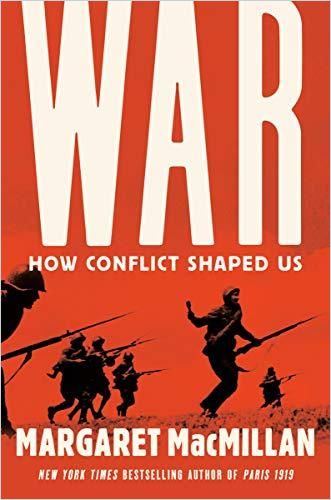Prolific historian Margaret MacMillan provides a stark, harrowing assessment of war’s past and its inevitable future.

War Endures
In this pessimistic, blunt exploration of humanity’s propensity for warfare and violence – A New York Times Book Review Ten Best Books of the Year – renowned historian and Oxford University Emeritus professor Margaret MacMillan demonstrates an astonishingly wide-ranging knowledge of conflict over the centuries. In the same paragraph, she might weave lessons from a Greek battle fought more than 2,000 years ago with observations from a 21st-century insurgency in the Middle East to produce groundbreaking insights into the psychology of war. MacMillan’s articulate – but nonlinear – approach may baffle some readers, but a compelling understanding of conflict and violence awaits those who follow her journey.
Too Few People
Humankind emerged about 350,000 years ago. The Earth had so few people, living so far from one another, that they had little opportunity for war. However, prehistoric skeletal remains suggest that people and tribes engaged in homicidal violence, which may have accounted for up to 25% of male deaths in primitive societies.
The evidence seems to be on the side of those who say that human beings, as far back as we can tell, have had a propensity to attack each other in organized ways – in other words, to make war.Margaret MacMillan
By the late Stone Age, MacMillan makes clear, people created weapons, formed bands and tried to kill one another.
Reasons for War
According to legend, the Spartans obliterated Troy over a kidnaped local beauty. France’s king died in 1328 without a clear heir, leading to a century of war between France and England. The Thirty Years’ War began in 1618 when Protestants in Prague threw the Austrian emperor’s Catholic emissaries out of a tower. In 1914, an assassin killed Ferdinand, Archduke of Austria, in Sarajevo. A spider’s web of alliances brought most nations into World War I, and by 1919, tens of millions lay dead in France and Eastern Europe. Aggressors strike at potential enemies before they grow stronger, as in World War II, when Germany preemptively attacked Russia and Japan bombed Pearl Harbor.
MacMillan lists pride, land, loot, enslaved people, honor and heroism as incentives for war. Avarice, greed and emotion drive most conflict. Betrayal, hurt pride and honor make civil wars the bloodiest.
Women, when they choose to fight or are obliged to fight, can be as fierce as men.Margaret MacMillan
Depressingly, human nature might make war, violence and conflict inevitable. Chimpanzees and bonobos share 99% of humans’ DNA. Chimps conduct warlike raids, but bonobos make love, not war. Humans make war like chimps and peace like bonobos.
Wars without clear objectives tend to escalate, deplete a nation’s treasure and drag on, as Americans learned in Iraq, Afghanistan and Vietnam.
More, Deadlier Conflicts
Iron, steel, gunpowder, artillery, armored vehicles, aircraft, submarines and weapons of mass destruction give nations and their allies enormous, if temporary, advantages – but only if they use them. The Persians, for example, fought with horses and chariots against Greek armor and pikes 3,000 years ago, paying dearly for their mistake. The Chinese invented gunpowder, but set it aside in the 15th century, leading to China’s defeat by the British in future wars.
Too often, those making the decisions for war assume that, somehow, victory will magically sort out all the problems.Margaret MacMillan
Failed logistics cost Napoléon the conquest of Russia in 1812. Hitler murdered or chased away his best scientists – particularly Jews – in World War II. Today, by the time sailors and pilots – themselves becoming obsolete – understand a new armament, it has lost its strategic edge.
Forever War
University curriculums neglect war, but the threat of war lurks everywhere and will not spare the young.
Since the Middle Ages, consolidation of fiefdoms and city-states into larger and fewer nations reduced the potential for war. Rome 2,000 years ago, England in the 19th century and America thereafter brought order, safety and peace.
A growing middle class and democracy somewhat stymied wars. Reluctance to fight proved a major cause, for example, of Russia’s collapse in the First World War.
One of the great tragedies of modern war was that the very strengths of societies – in organization, industry, science or resources – could turn them into such effective killing machines. Margaret MacMillan
Nations inspire support for war by demonizing and dehumanizing the enemy, making military service mandatory for every male and demanding everyone’s support. More efficient and effective means of raising money, food, materials, combatants and workers, the sophistication with which governments use propaganda, and nations’ ability to move rapidly to a war footing lead to “total war” – when governments marshal a society, its economy and its people. Thus, MacMillan teaches, certain technologies, infrastructure elements and economies make war more complete and destructive.
Real War
Modern war has no equal for killing, raping, enslaving and displacing noncombatants. Museums, monuments, books, movies, music and art glorify past wars, battles and fighters. Comics, television shows, monuments and language dramatize war as much as they admonish it.
How can we talk at all about controlling and managing something where violence is the tool and domination, if not the total destruction, of the enemy the goal?Margaret MacMillan
Even though warlike images fill TV and video game screens, few want to fight real wars. American and European voters have little appetite for total war.
No Control
The Great War and World War II, for example, rendered ridiculous international conventions, such as those in The Hague and Geneva banning brutal practices, safeguarding civilians and affording prisoners humane treatment.
Efforts to distinguish soldiers from guerillas, terrorists and resistance fighters have proven futile, as have war-crimes tribunals as a deterrent to atrocities. Some hoped – without result – that freer trade and economic globalization would render war economically impractical.
We who are noncombatants may fear the warriors, but we also admire, even love, them. And we cannot pretend that we are not part of the same family, with the same potential for fighting.Margaret MacMillan
People have great capacity for peace. Yet war and the threat of future war endure.
Indispensable but Pessimistic
MacMillan offers not exactly a history nor a moral treatise. Her thesis is that – no matter what your hopes – war is integral to human nature, human endeavors, human desires and human ambitions; war will never end. To bolster her thesis – which may depress you even as it does not surprise you – MacMillan calls upon a career’s worth of knowledge, both arcane and common. What makes her work an indispensable masterpiece for students, professors, politicians and policy makers is MacMillan’s flowing erudition and hard-earned pessimism regarding humankind’s prospects for peace. Ever.
Margaret MacMillan also wrote The War That Ended Peace, Paris 1919, Nixon and Mao, Dangerous Games and The Rhyme of History.




